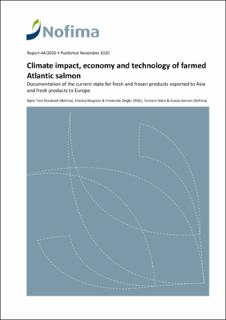| dc.contributor.author | Rotabakk, Bjørn Tore | |
| dc.contributor.author | Bergman, Kristina | |
| dc.contributor.author | Ziegler, Friederike | |
| dc.contributor.author | Skåra, Torstein | |
| dc.contributor.author | Iversen, Audun | |
| dc.date.accessioned | 2023-09-07T08:20:42Z | |
| dc.date.available | 2023-09-07T08:20:42Z | |
| dc.date.created | 2020-12-23T09:29:35Z | |
| dc.date.issued | 2020 | |
| dc.identifier.isbn | 978-82-8296-661-0 | |
| dc.identifier.uri | https://hdl.handle.net/11250/3087861 | |
| dc.description.abstract | As a part of the project “Nye metoder for bedre holdbarhet og mer miljøvennlig transport av lakseprodukter” (New methods for improved shelf life and more sustainable salmon products), this report documents the current status of the products exported to Paris and Shanghai from an environmental, economic and technological point of view. Six value chains were studied; head-on gutted or fillet, transported fresh by airplane or frozen by boat to Shanghai and transported fresh by truck to Paris, example value chains chosen to represent important current markets for Norwegian farmed salmon. The value chain for fresh salmon is well adapted to shipment in EPS-boxes with ice as a cooling media. Alternatives to ice exist, but they have not been implemented on a large scale by the industry. The freezing time can be reduced significantly from today’s 12-24 hours which has been reported by choosing existing solutions. Airfreight dominates the total climate impact of the product, and transporting fillet instead of head-on gutted fish gave a 20 % reduction in climate impact. Also, a frozen product transported by ship to Shanghai resulted in half the climate impact of fresh salmon flown to the same destination. Cost of transportation is a minor cost component when transportation is by road to Europe, at around 4% of the export price, while airfreight to Asia adds 26 %. Switching from fresh to frozen products for Asian markets has roughly an 85 % cost-saving potential on transportation. | |
| dc.description.abstract | Climate impact, economy and technology of farmed Atlantic salmon – Documentation of the current state for fresh and frozen products to Asia and fresh products to Europe | |
| dc.description.abstract | Klimaavtrykk, økonomi og teknologi knyttet til oppdrettslaks – Dokumentasjon av dagens status på ferskt og fryst produkt til Asia og ferskt produkt til Europa | |
| dc.language.iso | eng | en_US |
| dc.publisher | Nofima AS | en_US |
| dc.relation.ispartof | Nofima rapportserie | |
| dc.relation.ispartofseries | Nofima rapportserie; | |
| dc.title | Climate impact, economy and technology of farmed Atlantic salmon – Documentation of the current state for fresh and frozen products to Asia and fresh products to Europe | en_US |
| dc.title.alternative | Climate impact, economy and technology of farmed Atlantic salmon – Documentation of the current state for fresh and frozen products to Asia and fresh products to Europe | en_US |
| dc.title.alternative | Klimaavtrykk, økonomi og teknologi knyttet til oppdrettslaks – Dokumentasjon av dagens status på ferskt og fryst produkt til Asia og ferskt produkt til Europa | en_US |
| dc.type | Research report | en_US |
| dc.description.version | publishedVersion | |
| dc.description.version | publishedVersion | |
| dc.description.version | publishedVersion | |
| dc.source.pagenumber | 14 | en_US |
| dc.source.issue | 44/2020 | en_US |
| dc.identifier.cristin | 1863000 | |
| dc.relation.project | Nofima AS: 13101 | |
| dc.relation.project | Fiskeri- og havbruksnæringens forskningsfinansiering: 901635 | |
| cristin.ispublished | true | |
| cristin.fulltext | original | |
| cristin.fulltext | original | |
| cristin.fulltext | original | |
